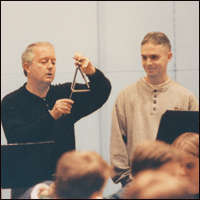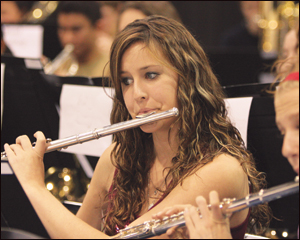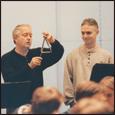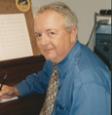Music teachers want their honor groups to run smoothly, especially if they invite a guest composer or clinician to rehearse and conduct a concert. That being said, over the past 32 years I’ve been witness to any number of misadventures, from scheduling mishaps and equipment shortages to missing parts that have hindered my work at the podium as a guest. Although some of these seem humorous now, the sad fact is that most of the mistakes caused serious problems for the students and hampered their opportunity to present the best possible performance. Here are some suggestions for advanced planning and organization that are essential for honor groups when a guest leads the ensemble.
Part Assignments
Parts that are incorrectly assigned to players’ folders cause unnecessary confusion and lengthy rehearsal delays. A plan for passing out parts will keep the flow of rehearsals moving smoothly.
1. Read through the designated instrumentation on the title page of the full score, and make sure all of the parts are distributed. Newer works often have three flute parts and some have four trombone parts, so watch for this and make sure the parts are assigned properly.
2. A general rule for distributing parts in school honor bands is to have more players on the second part than the first, and more on the third part than the second. If there are four parts, distribute the third and fourth parts equally.
3. Modern band works often have four trumpet parts and three separate flute parts. Be certain to put all parts in the folders. Directors should never put more than four players on 1st trumpet, no matter how large the band might be. With older works, the parts should be distributed this way:
Solo and 1st Cornets – 1st trumpets
Trumpets 1 and 2 – 2nd trumpets
2nd Cornets – 3rd trumpets
3rd Cornets – 4th Trumpets
 Note that in older transcriptions the 1st and 2nd trumpet parts are essentially the original orchestral trumpet parts. Directors frequently hand out the trumpet parts for transcriptions to 3rd and 4th players, which can be disastrous. These parts should always be played by better students.
Note that in older transcriptions the 1st and 2nd trumpet parts are essentially the original orchestral trumpet parts. Directors frequently hand out the trumpet parts for transcriptions to 3rd and 4th players, which can be disastrous. These parts should always be played by better students.
4. If the score calls for flugelhorns, be sure to put these parts in the folder. It is always best if two of the better players bring flugelhorns for these parts (only one is needed on each voice). Assigning students to play flugelhorn parts on trumpets completely destroys the intention of the composer, who wrote for flugelhorn because of the difference in color.
5. When the score indicates Eb soprano clarinet, designate one of the 1st clarinets to play this part and do so far in advance so the student can practice for rehearsals and the concert far enough in advance. Eb soprano clarinets are treacherous little creatures and need to be played by someone who knows what they are doing. So few new works call for the Eb soprano that it is not a good idea to audition someone just to play the instrument. If you insist on doing this, have the student bring a Bb clarinet also, so he can play with the 1st and 2nd clarinets on the pieces that do not indicate Eb soprano clarinet. The same goes for Eb alto clarinet; if you insist on including an alto clarinetist (or heaven forbid, more than one), have him bring his Bb clarinet to play with the 3rd clarinets on the pieces that do not call for an Eb alto clarinet. Whatever you do, don’t hand this player an alto saxophone part just to have something to play. This is disastrous.
6. The standard dilemma with Eb contralto and Bb contrabass clarinets should be solved before the clinician arrives, and the correct parts should be distributed to the folders.
7. Percussionists need at least two of each part so they don’t have to carry music around from stand to stand while switching instruments. This is especially true with mallet players.
The First Rehearsal
Anyone with extensive experience conducting honor bands will tell you that the first rehearsal is the most important. If things run smoothly and efficiently from the very beginning, all will usually go well; however, if the first rehearsal is chaotic, students never seem to settle in to the task at hand.
1. The clinician should send the people in charge of running the honor band a general setup chart far in advance of the date. I say general because often the exact instrumentation is unknown and the rehearsal room and stage are unfamiliar. The seating chart might require changes later because of physical or acoustical problems at the venue.
2. All chairs, stands, and percussion equipment should be set up before students arrive for the first rehearsal.
3. All seating assignments should be handled by the hosts, either by having the band show up 30 minutes early to seat the players or by using name cards on the music stands to indicate where students sit. It should not be the clinician’s job to seat a 90- to 120-piece band he has never seen.
4. Assign the piccolo player, English horn player, the Eb clarinetist, and the soprano saxophonist (if necessary) well before the first rehearsal. It is not the job of the clinician to make these decisions; the people who auditioned the students should make them.
5. Each tuba player and all other large instruments should have their own music and stand. It is truly difficult for these players to read with two people per stand.
6. Make certain that percussionists have at least 15 music stands available. They will need all of them to correctly set up the section. They also need all the necessary suspended cymbal stands, snare mounts, gong beaters, and so forth on site before the rehearsal begins.
7. A percussion instructor or the person who auditioned the percussionists should attend the first rehearsal to assign parts for each piece. If this is not done, the first rehearsal will be a train wreck. Clinicians have never before laid eyes on these students; they have no idea who should be assigned to play which part.
8. All percussion equipment should be in working order. It is frustrating to try to rehearse when the necessary instruments and beaters are unavailable or when equipment such as timpani, vibraphone (including a power cord for the motor), and chimes are not functioning properly.
9. A librarian should be at the initial rehearsals to ensure that all students have the music they need. There is nothing more embarrassing for a student than sitting through half of the first rehearsal without a part because there is no librarian present to address these problems.
10. One host or teacher should be at every rehearsal, in case a student becomes ill, the clinician needs help getting a missing part, or, as once happened to me, to find the switch when the lights go out.
Successful Concerts
1. Under optimum conditions, the honor band should rehearse where it performs. If this is not possible, then it is imperative that band members have at least one rehearsal in its concert venue. If the latter is the case, all the necessary percussion equipment should be moved with the band to this site.
Starting over with different timpani and different mallet instruments in the concert venue is a poor idea because the mallet players often have to select completely different mallets and the timpanists have to start over tuning a new set of drums. I see this all the time. It never ceases to amaze me why school music teachers do this to their students. No one would hand out a different set of wind instruments to the players just before a concert. Why do this to the percussionists?
 2. Provide all instructions to students about where to be and what to do in writing before they arrive at the clinic. Considerable time in a final rehearsal can be wasted on these announcements.
2. Provide all instructions to students about where to be and what to do in writing before they arrive at the clinic. Considerable time in a final rehearsal can be wasted on these announcements.
3. If more than one band is performing on the concert, please don’t sequester your top band students in a room for two hours before they perform. This may be easier for music teachers and their bus schedules, but it is definitely detrimental to good concentration. Students get bored, start jabbering, and pretty soon the band loses focus. A more sensible and educational alternative is to reserve seats in the concert hall so students in the top band can hear other groups play. They should excuse themselves about 30 minutes prior to their performance to warm up. This is plenty of time for the clinician to tune the band before the concert.
4. When staging several bands on a concert, the host needs plenty of help to execute set-up changes. Recruit all the people you can, draw up
accurate set-up charts, and put everyone to work. The better this is organized, the better the concert will flow.
5. Keep all speeches and award presentations to a minimum. Parents come to hear their children play, not to hear teachers talk. I know this is a touchy subject, but I have seldom been to a band concert that was too short. Some honor band concerts become seemingly interminable because of lengthy speeches and slow set-ups.
6. Please assign a teacher or student to drive the clinician back to the hotel after rehearsals and the performance. After several hours on the podium, it is not much fun sitting around a band room for two hours while the host is tidying up. After all, the best thing about being a guest clinician is, for this one concert, not having to move the drums.
I hope these suggestions are helpful in making honor band weekends more successful. With a little planning and forethought, any honor band weekend can run as smooth as silk.






